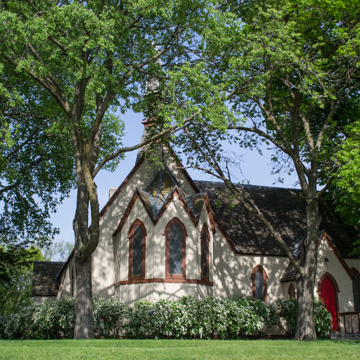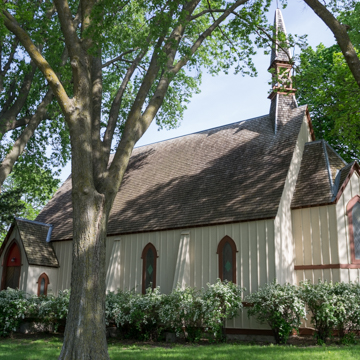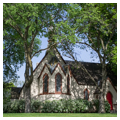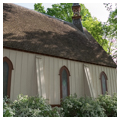Built in 1872, just five years after Nebraska achieved statehood, St. Stephen’s Episcopal Church is the oldest church in Ashland and recognized as a local landmark. Although difficult to appreciate today because of its immediate surroundings, the church is set on the crest of a knoll, a common practice at the time of its construction.
The small wood-framed church, a modest interpretation of Gothic Revival architecture, it is one of Nebraska’s best examples of the style. Elements of the style include a steeply pitched gable roof, board and batten cladding, wood buttresses that in this instance serve more of an aesthetic than structural function, and tall, narrow lancet arched window and door openings. Appendages to the rectangular nave include a polygonal apse on the east enlivened by three small gables, the principle entrance on the southwest corner, and a parish hall on the north added prior to 1906. Prominent features of the well-preserved interior include two tiers of wood cross beams, which support the roof, and a continuation of the pointed arch motif displayed in the detail of the chancel opening and wood frames on either side. Extant interior furnishings include pews, chancel appointments, and the organ—a rare and beautiful instrument.
Since the design of the church closely resembles work associated with Richard Upjohn, historians have raised questions regarding the extent of his influence. Upjohn was a major figure in the popularization of Gothic Revival churches during the nineteenth century. His concern for the plight of small congregations desiring to build a house of worship with limited financial resources resulted in his publishing the book, Upjohn’s Rural Architecture, in 1852. Distributed throughout the United States, the pattern book contained plans and complete details for construction and furnishings for small churches. It was especially suited to the skills and materials available to local builders. The architect/builder of the Ashland church is currently unknown. Further research is required to ascertain the relationship of Upjohn’s influence on the design.
With the passage of time the congregation dwindled in size. In 1992 the Episcopal Diocese of Nebraska closed the church and sold it to the Ashland Arts Council. Though it retains the name, today St. Stephen’s is no longer a church but a noteworthy historic structure that accommodates a variety of community functions.



















